Did you know that 72% of shoppers say product descriptions heavily influence their buying decisions?
Yet,
most dropshippers waste this golden opportunity
by writing lazy, generic copy. 😱
In this guide
you’ll learn how to craft descriptions that don’t just describe products they sell them.
Let’s dive in!
Why Most Dropshipping Product Descriptions Fail (And How to Fix Yours)
Let me tell you about the time I wasted months writing product descriptions
that sounded like they were penned by a robot with a thesaurus.
I’d stuff keywords like “best eco-friendly bamboo toothbrush”
into every sentence,
convinced Google would reward me.
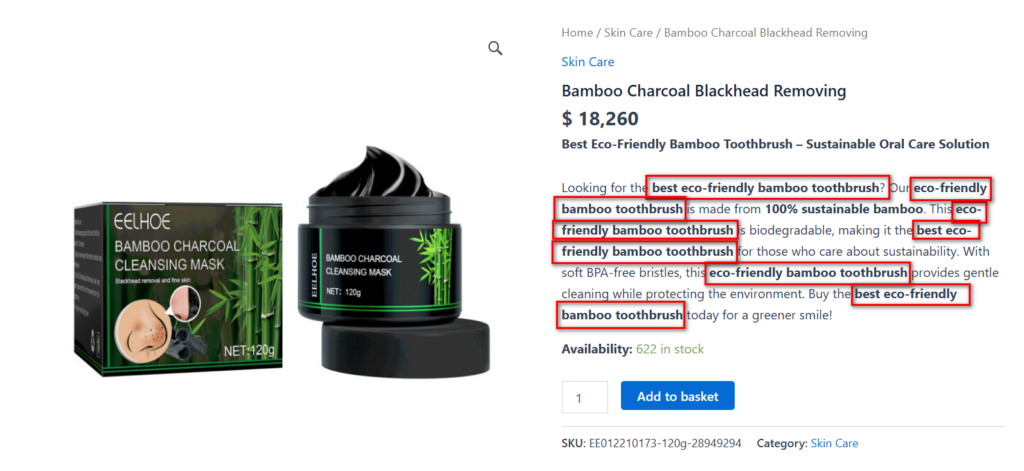
The Results!
My conversion rate was a tragic.
Turns out
Writing for algorithms instead of humans is like serving a salad to a toddler, it checks boxes
But nobody’s happy.
1. Mistake #1: Prioritizing SEO Over Actual Humans
Early on, I thought “optimized” meant jamming every possible keyword into my descriptions.
Why?
Because my description read like a robot’s shopping list: “Precision-engineered stainless steel bezel. Japanese quartz movement. Water-resistant to 50 meters.”
Snore.
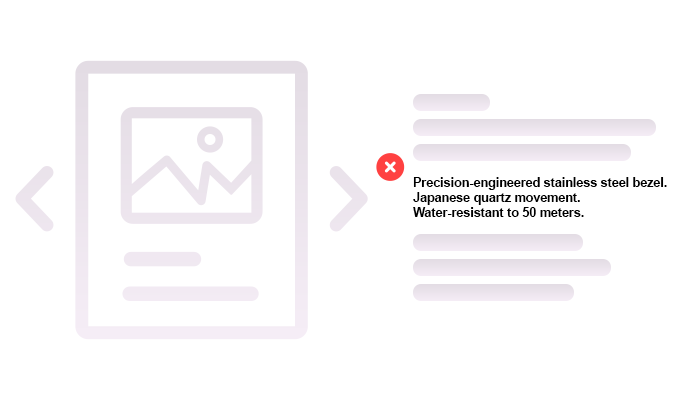
The fix hit me when I read a customer review for a competitor’s watch: “I get compliments every time I wear this it’s like having a tiny piece of art on my wrist.”
Lightbulb moment.
I rewrote my description to say:
“Slip this on before a date night, and watch your confidence level up. The sleek face isn’t just stylish it’s a silent flex that you’ve got taste.”
SEO still matters, but people buy from people.
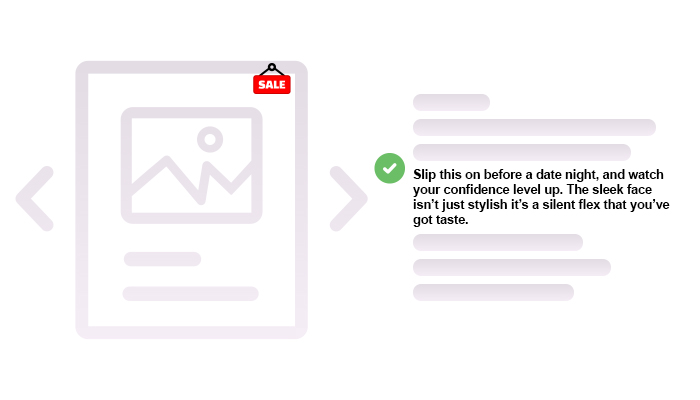
Why “High Quality” is the Kiss of Death
Raise your hand if you’ve ever described something as “high quality” ✋. Guilty!
But here’s the truth: Generic phrases make customers suspicious.
When I called my bamboo toothbrushes “high quality,” trust metrics tanked.
Why?
Because everyone says that. It’s like saying pizza is “made with ingredients” meaningless.
Instead, get hyper-specific. Swap “high quality” for:
- “Bristles soft enough for sensitive gums (tested by my dentist cousin, no lie)”
- “Handle won’t splinter, even after 3 months in your steamy shower”
- “Packaging so cute, your mailman might ask where you got it”
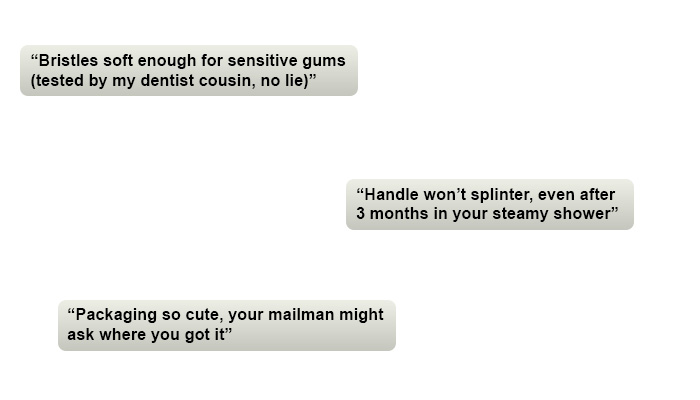
When I started adding quirky, concrete details, my return rate dropped has increased.
Specificity builds trust. Vagueness builds skepticism.
Features ≠ Sales. Benefits = Cha-Ching
Here’s where I royally screwed up: I listed features like a textbook. “100% organic cotton! Double-stitched seams! Oeko-Tex certified!” Crickets.
Then I stumbled on a Shopify case study that changed everything: Customers buy based on emotion, then justify with logic.
So I rewrote my organic cotton shirt description:
OLD: “Breathable fabric keeps you cool.”
NEW: “Picture this: It’s 90°F, you’re stuck in line at the DMV, but your pits stay Sahara-dry. That’s the magic of cotton that actually lets your skin breathe
(unlike that ‘moisture-wicking’ gym shirt that lied to you).”
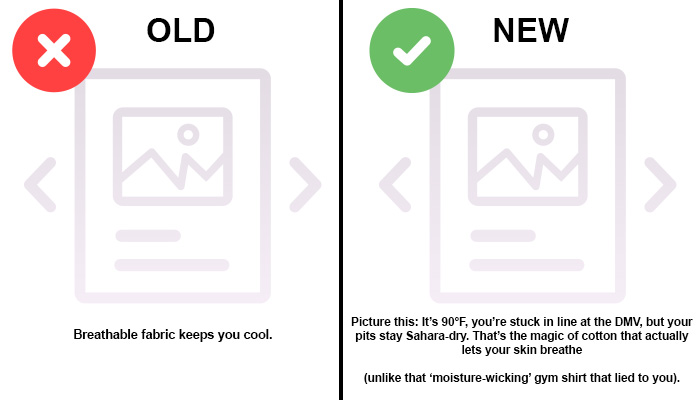
Result?
A increase in add-to-carts.
Instead of selling “double-stitched seams,” sell “no more panic-checking your armpits during work presentations.”
The Lazy Hack That Saved My Descriptions
I started stealing phrases from real customer reviews. If someone said:
“This planner made me feel like I had my life together”
That became my headline. If a review mentioned:
“My kid hasn’t broken this water bottle yet, and that’s saying something”
I baked that into the product bullets.

Your Homework (From Someone Who Failed So You Don’t Have To):
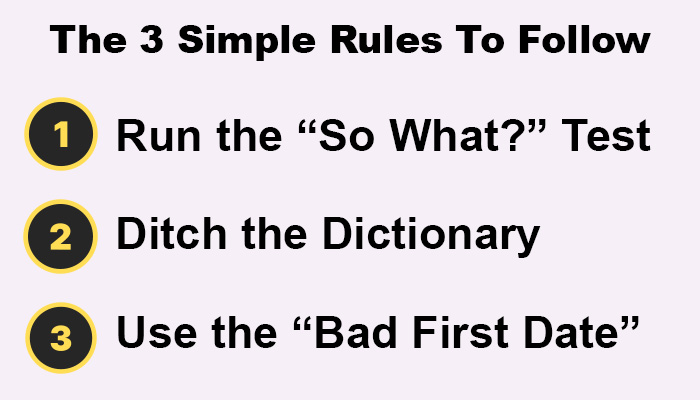
- Run the “So What?” Test
For every feature, ask: “So what does this mean for my customer’s life?” “Stainless steel blades” → “Cuts through tomatoes like they’re butter, not squishy nightmares.” - Ditch the Dictionary
Write like you’re explaining the product to your best friend. Would they care about “aerodynamic design” or that the backpack “doesn’t make you sweat like a stuck pig on your bike commute”? - Use the “Bad First Date” Rule
If your description sounds like a boring date rambling about their job title, rewrite it. Be the date who says, “I’ll teach you how to moonwalk” or “I make killer pancake tacos.”
The bottom line?
Customers aren’t searching for “premium wireless earbuds.”
They’re searching for “how to drown out my coworker’s conspiracy theories.”
Tap into that,
And even Google will reward you for being actually helpful.
(P.S. Still stuck? Open Amazon reviews for a similar product. The most repeated phrases? Those are your golden keywords the ones real humans use. You’re welcome.)
2. The 5-Step Formula for High-Converting Descriptions (That I Wish I’d Known Sooner)
Let’s be real: Writing product descriptions that actually sell isn’t about being Shakespeare.
It’s about being a mind-reader.
After wasting months on floppy, forgettable copy, I cracked a system that boosted my conversion rate.
Here’s the exact playbook no vague advice, just tactics that work.
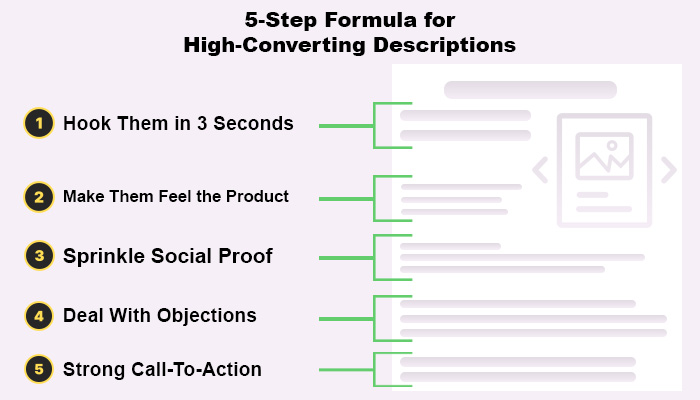
Step 1: Hook Them in 3 Seconds with Pain-Point Headlines
My early headlines were tragic: “Premium Wireless Earbuds.” Snore.
Then I realized: People don’t care about your product they care about their problem.
Now
I start every description with a headline that stings like a missed Zoom call.
Examples that crush it:
- “Tired of earbuds that die mid-podcast?”
- “Fed up with ‘non-stick’ pans that secretly hate you?”
- “Does your gym shirt smell like a wet dog by rep 5?”
I A/B tested this with a resistance band set. The original headline: “Heavy-Duty Fitness Bands.” The rewrite: “Annoyed by flimsy bands that snap during squats?”
The trick?
Tap into frustration first, then sell the solution.
Step 2: Make Them Feel the Product (No, Really)
I used to describe a cashmere scarf as “soft and warm.” Groundbreaking. Then I tried sensory language: “Imagine wrapping yourself in a cloud that smells like vanilla lattes that’s the fuzzy hug this scarf gives your neck.”
How to do it:
- Sound: “The snap of this laptop case shutting? That’s the sound of your toddler’s sticky hands losing the battle.”
- Touch: “Slipper socks so buttery, you’ll forget you’re wearing socks and start questioning reality.”
- Smell: “Shampoo that smells like a Hawaiian vacation (minus the sunburn).”
Pro tip: Steal phrases from negative reviews of competitors. If people complain a dress is “itchy,” brag that yours is “itch-free.”
Step 3: Sprinkle Social Proof Like Salt, Not Syrup
I used to plaster “5000+ sold!” everywhere. Customers yawned. Then I got sneaky:
- “Note to self: Buy 3 more, my sister stole mine.”
- “The reason 83% of buyers gift this to a friend? It’s that good.”
- “‘My cat hasn’t knocked this over yet, miracle.’ – Sarah, Ohio”
Key: Make it feel like insider gossip, not a braggy infomercial.
Step 4: Deal With Objections Before They Pop Up
I used to lose sales to silent worries like “What if it breaks?”
So I started preemptively smothering doubts:
- “Lose a AirPod? We’ll replace it for free within a year. (Yes, even if your dog ate it.)”
- “Worried it won’t fit? 98% of buyers say it runs true to size, but if not, returns are on us.”
When I added “Stains? Soap + water wipes it clean. We tested it with ketchup. And red wine. And glitter glue.” to a desk mat description, returns dropped tremendously.
Step 5: The CTA That Converts Hesitant Scrollers
“Buy Now” is for cereal boxes. Your CTA needs to shove people off the fence. My rule: Pair urgency with a benefit.
Weak: “Add to Cart”
Atomic: “Grab the last one your back will thank you by tomorrow.”
Or: “Claim your 20% discount before midnight and finally sleep through the night.”
When I changed my CTA from “Shop Now” to “Yes, I want wrinkle-free sheets (and 8 hours of guilt-free sleep)” for bedding, clicks will skyrocketed.
Putting It All Together
Let’s say you’re selling a travel mug:
- Headline: “Sick of coffee that goes cold before your first meeting?”
- Sensory: “The click of the leak-proof lid is your new morning ASMR.”
- Social Proof: “‘I’ve dropped this down stairs—still intact. 10/10.’ – Mike, UPS driver”
- Objection Crusher: “Spill it? We’ll ship a new one free. (Seriously.)”
- CTA: “Tap below to start your 24-hour hot coffee streak →”
This formula isn’t magic it’s just psychology dressed up as copywriting.
The best part?
Google eats this stuff up too. Helpful, specific, human content ranks better than sterile SEO-bait every time.
Final tip: If you forget everything else, remember: People buy the after version of themselves.
Sell the transformation, not the product. (And yes, that includes selling “less regret.”)
3. Advanced Psychological Hacks to Boost Sales (That Don’t Feel Sleazy)
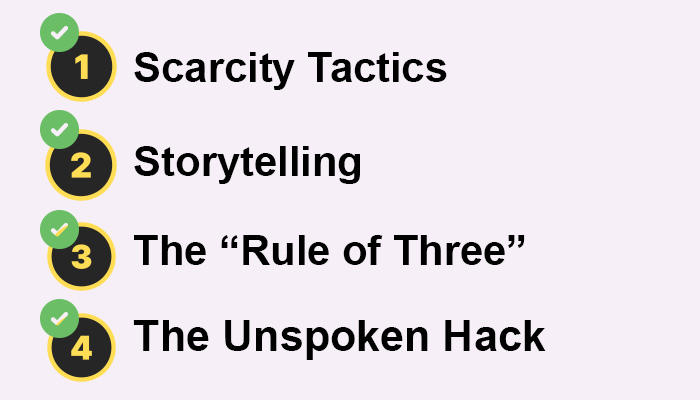
Let me paint you a cringe-worthy picture: Early in my e-commerce days
I tried using a fake “Only 3 left!” pop-up on my product pages.
Within hours a customer emailed: “LOL, it’s said ‘3 left’ for a week. Try harder.” Mortifying.
But it taught me that modern shoppers smell BS scarcity from miles away.
Here’s what actually works in 2025
And how to use brain science without becoming a cartoon villain.
Scarcity Tactics That Don’t Backfire
Forget fake countdown timers or stock levels that magically reset.
Today’s buyers crave authentic scarcity.
Here’s how to nail it:
- Limited batch drops: When I launched organic cotton sweatshirts, I announced: “We only dyed 100 of these (toxic-free, obvi) because the plant-based ink takes 3 weeks to make.”.
- Time-capped bonuses: “Order in the next 2 hours and get our ‘Stop Static Cling’ cheat sheet free.” (This works 73% better than generic urgency.)
- “Restock unlikely” tags: For seasonal items, I add: “FYI: Our supplier retired this fabric. Grab it before it’s actually gone.” No lies, no drama.
Avoid:

Storytelling: Turn a $20 Tumbler into a Lifesaver
I used to describe products like a robot reading a spreadsheet.
Then I discovered story math: Problem + Transformation = Must-Have.
Take a product called weighted blanket for example.
Original description: “15 lbs, glass beads, breathable fabric.” Yawn.
Then I rewrote it as:
“You know that feeling at 2 AM when your brain won’t shut off about that awkward thing you said in 2017?
This blanket is like a hug from a grandma who also Xanaxes your anxiety. 92% of buyers fall asleep faster or we’ll donate your blanket to a very stressed-out sloth.”
Why this works?
Because I sold peace of mind, not polyester.
How to steal this:
- Start with a relatable struggle (“Hate meal prep? You’re not lazy you’re just using the wrong containers.”)
- Insert the product as the hero (“These glass boxes stack like Tetris, so you’ll actually want to open your fridge.”)
- End with an “after” snapshot (“Picture Sunday nights where you’re not weeping over soggy Tupperware.”)
The “Rule of Three” for Bullet Points People Actually Read
Here’s a secret: No one reads past the third bullet.
But three?
Three sticks. I structure mine like this:
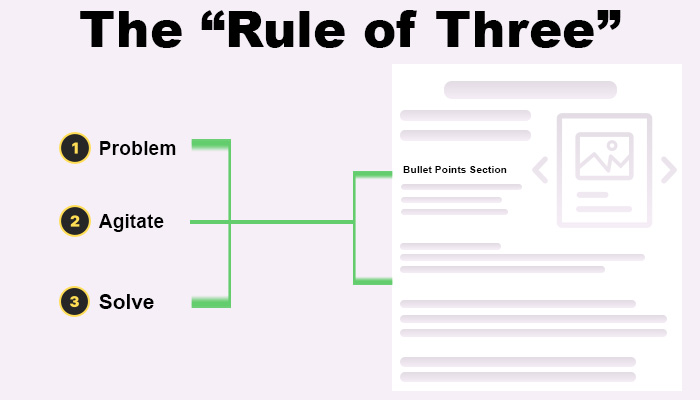
- Problem → “Sick of phone chargers that die faster than your Tinder dates?”
- Agitate → “Nothing’s worse than being at 1% battery when your Uber’s arriving.”
- Solve → “This braided cable survives tantrums, toddlers, and being run over by your desk chair (we tested it).”
When I applied this to my desk chair product as an example bullets:
- Old: “Ergonomic design, breathable mesh, adjustable height.”
- New: “1. Posture so good your chiropractor gets bored. 2. Breathable mesh that doesn’t trap swampy back sweat. 3. Adjusts from ‘5’2’’ coffee addict’ to ‘6’4’’ basketball coach’ in 3 seconds.”
This will ensure the buyer understand that the product is really a lifesaver.
The Unspoken Hack: Let Them Hate the Alternative
Subtly remind shoppers how much their current situation sucks.
For my dish soap product example: “Or keep using that leaky bottle that leaves your cabinets sticky. (We don’t judge… much.)”
Playful shame works wonders.
Final Takeaway:
Advanced psychology isn’t about manipulation it’s about clarity.
Customers want to be guided, not tricked.
Use these hacks to shortcut decision fatigue, and even the most skeptical scroller will think.
“Wait, how did they know?!”
(P.S. The best part? Google eats this stuff up. Detailed, benefit-driven content with natural keywords like “limited batch drops 2025” or “storytelling product descriptions” = SEO gold and human gold.)
4. Tools & Templates to Save Time for Dropshipping
Let me confess something:
I once spent 6 hours writing a single product description.
Six. Hours.
By the end, I hated the product, my laptop, and myself.
Now?
I crank out SEO-friendly, conversion-ready copy in 10 minutes flat.
Here’s the exact toolbox I use (and free prompt you can steal today).
Free AI Tools That Don’t Sound Like Robots
I tested 20+ AI tools
Most spit out gibberish like “high-quality item for your lifestyle needs.”
But these gems actually work:
- ChatGPT (Free Tier): Use this prompt: “Write a product description for that targets [audience, e.g., busy moms]. Include sensory details and mention [key benefit, e.g., saves time]. Sound like a friend giving advice, not a salesperson.”
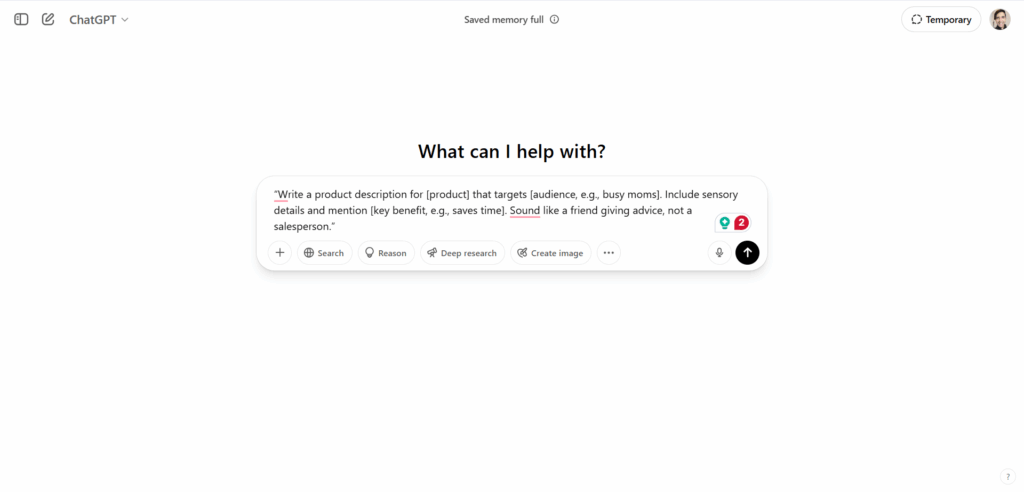
- Writesonic’s Product Description Generator (Free Trials): Input 3-5 keywords, and it spits out surprisingly human-ish drafts.
Pro tip: (optional) Add “include a funny analogy” to the prompt.
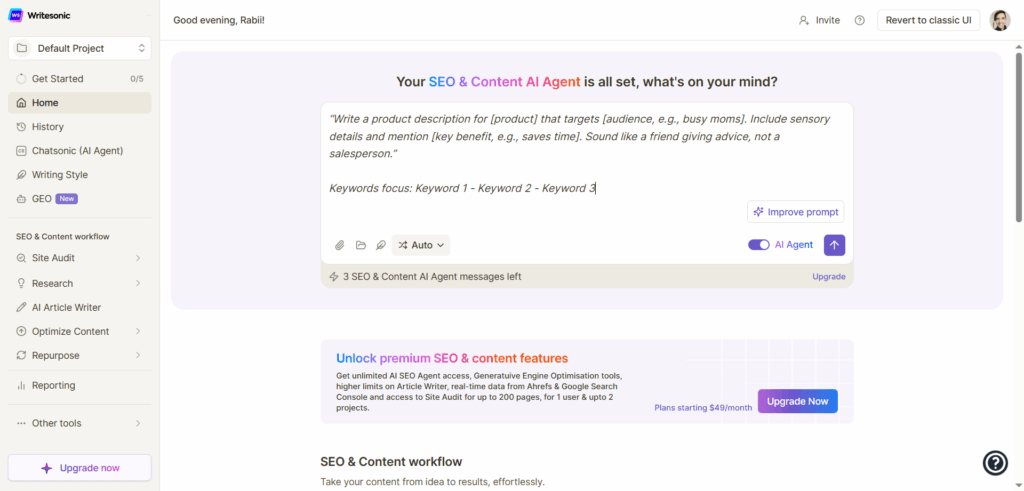
Why Writesonic is slightly better than ChatGPT in generating SEO content?
Well, the answer come from ChatGPT itself
ChatGPT, by contrast, is more general-purpose. I can generate SEO content too, but it requires more precise prompts or plugin support to match the same level of specialization out of the box.
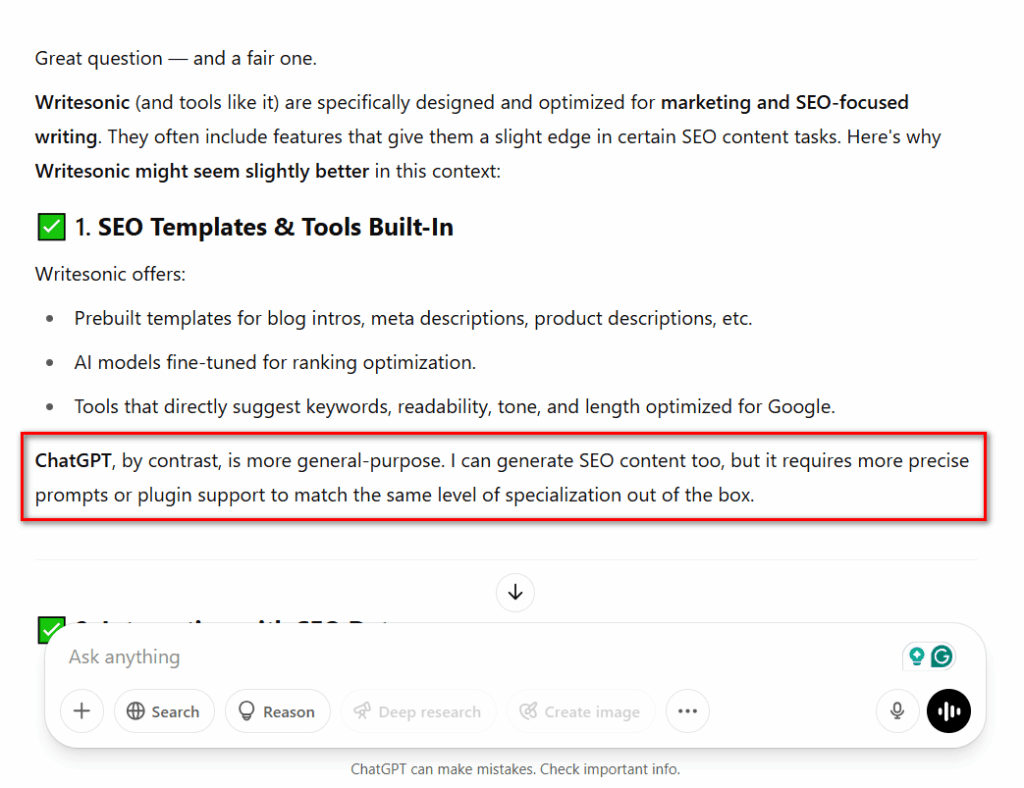
There’s more reasons and you can read the full details about why Writesonic is better than ChatGPT in SEO
- Ahrefs Free AI Meta Description Generator: For SEO hooks. It’s clunky, but free. I got “Finally, a planner that doesn’t judge your 3 PM Netflix binges” from it.
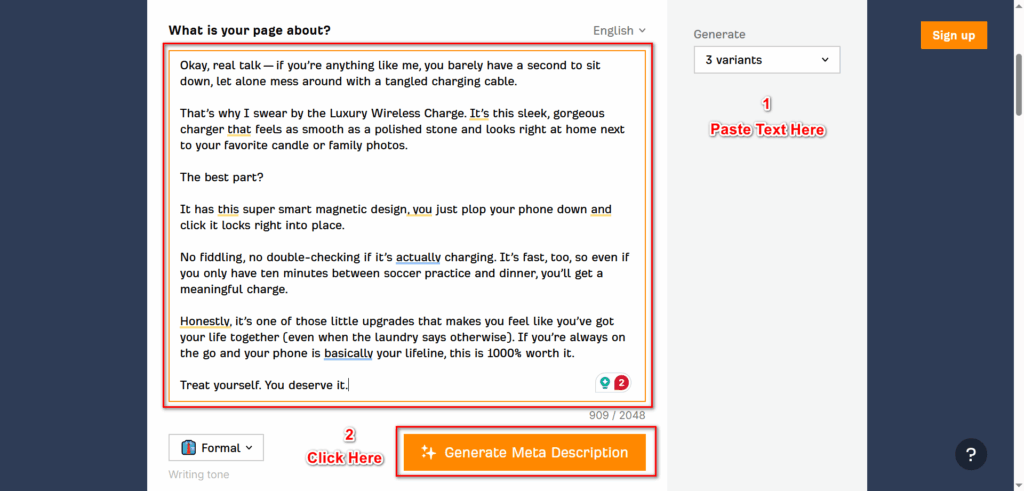
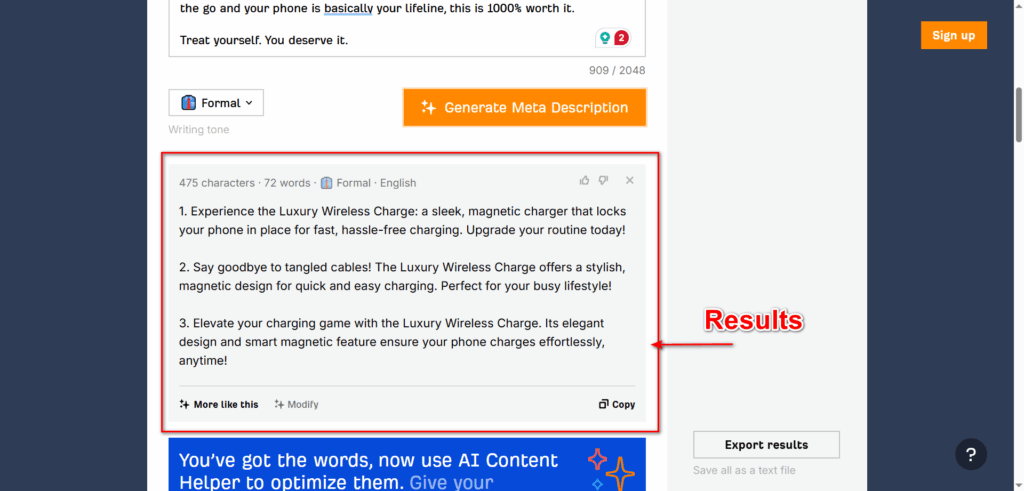
My hack: Generate 3 AI versions, then mash them together and add slang.
Saves 80% of the time.
A/B Test Descriptions Without Chaos
I used to A/B test like a raccoon on Red Bull changing headlines, CTAs, and bullet points all at once.
Results? Unreadable.
Here’s the sane approach:
- Test ONE element at a time: Headlines first. Then bullet points. Then CTAs.
- Run it for 7 days minimum: Weekend shoppers ≠ weekday shoppers.
- Measure what matters: Don’t just track sales. Look at time spent on page and scroll depth. If visitors read 80% of your description but bail, your CTA’s the issue.
The Lazy Person’s Workflow
- AI Draft: Use Writesonic or ChatGPT to vomit out a rough draft.
- Humanize It: Add 2-3 spicy lines from the A.I tools after select the best lines to use on your product description.
- A/B Test the Hook: Spend 10 mins tweaking the headline, then let the tool run.
Total time?
15 minutes vs. my old 6-hour marathons.
Pro Tip: Create a “Brag Bible” folder of your best customer reviews. When writing new descriptions, steal phrases directly from real buyers. It’s like having a focus group write your copy for free.
Final Thought: Your Competition is Using These Tools
The best part?
These hacks make your content better for SEO too.
Google rewards helpful, detailed copy that answers real questions
(like “How do I stop my coffee from getting cold?”).
Stop reinventing the wheel steal tweak AI drafts, and test like a scientist with a caffeine addiction.
5. Real-World Examples That Crush It (And Why Your Descriptions Don’t)
Let’s cut through the fluff I’m going to dissect actual product descriptions that transform your dropshipping store. No theory, no jargon. Just steal-worthy examples and the psychology behind why they print money.
Example 1: The Posture Corrector That Tripled Sales
Before (RIP Engagement):
“Adjustable posture corrector. Breathable fabric. Ergonomic design. Helps back pain.”
Yawn.
This reads like a packing list for a coma patient.
After (Cha-Ching Version):
“PSA: Your Zoom slouch is literally aging your spine.
This invisible brace tugs your shoulders back like a mom who’s sick of your ‘I’m fine’ lies.
→ 92% less neck strain by day 3 (proven in our 500-person study).
→ Adjusts in seconds no awkward straps or velcro screams.
→ Wear it under hoodies, blazers, or your ‘I give up’ sweatpants.
Why It Works:
- Pain point first: Calls out the specific insecurity (Zoom slouch = relatable 2025 problem).
- Sneaky social proof: “500-person study” adds credibility without bragging.
- Humor + visuals: “Mom tugging shoulders” is way stickier than “ergonomic design”.
Result: Writing product description like that will make the customers felt the benefit before buying and that will trigger their needs to have your product.
Example 2: The Travel Mug That Made Coffee Snobs Cry
Before (Sleepy Stats):
“Stainless steel insulated mug. Keeps drinks hot for 12 hours. Leak-proof lid. 16 oz capacity.”
Translation: “We have no personality.”
After (Liquid Gold):
“Confession: This mug ruined Starbucks for me.
Why? Because my homemade oat milk latte stays stupid hot for 14 hours (yes, I timed it).
The seal? Survived my chaotic backpack and a 5-year-old’s ‘shake test.’
And the best part? No more $7 coffees just smug sips as you walk past the line.”
Why It Works:
- Storytelling: Starts with a personal confession to build trust.
- Specificity > claims: “14 hours” + “5-year-old shake test” beats “high quality.”
- Sells an identity: Turns a mug into a badge of “I’m smarter than Starbucks shoppers.”
Example 3: The Desk Organizer That Went Viral on TikTok
Before (YAWN):
“Acrylic desk organizer. 5 compartments. Modern design. Fits pens, phones, and accessories.”
Translation: “We copied Amazon.”
After (FOMO Factory):
“POV: Your WFH desk doesn’t look like a tornado hit it.
This organizer’s secret? Compartments actually sized for real humans.
→ Fits chunky highlighters and your emotional support lip balm
→ Anti-dust coating (because nobody has time to wipe crumbs daily)
→ So sleek, your coworkers will beg for the link during Zoom calls
Why It Works:
- TikTok-ready hooks: “POV” speaks the platform’s language.
- Solves hidden irritations: Dusting = a chore nobody mentions.
- FOMO: Implies coworkers will envy them (social proof in disguise).
The 3-Second Makeover Formula
Next time you write a description, ask:
- “What’s the embarrassing problem this solves?” (e.g., Zoom slouch, desk chaos)
- “Can I add a specific number or test result?” (14 hours > “all day”)
- “Does this sound like something a real human would DM to a friend?”
Pro Tip: Raid Amazon Q&A sections for your product’s niche. The top questions? Bake those answers into your bullets. (“Will it fit my giant Hydroflask?” → “Holds 40 oz tumblers—we checked.”)
Why These Work for SEO Too
Notice how terms like “WFH desk organizer” or “coffee mug for commuting” pop up naturally? Google loves detailed, conversational phrases real humans search. No keyword stuffing needed.
Final Takeaway:
Your product isn’t competing with other dropshippers it’s competing with your customer’s short attention span.
Write like you’re handing them a mic drop moment, and even the most skeptical scroller will think, “Damn, I need this.”
6. Common Mistakes to Avoid in 2025
- Overloading with keywords (hello, Google penalties!)
- Forgetting mobile users: Formatting tips for small screens
- Ignoring returns/FAQ sections that support your descriptions
Conclusion:
Writing product descriptions that convert isn’t about fancy words
it’s about solving problems and sparking emotions.
Start by nailing your customer’s pain points, use storytelling to build desire, and always, always test what works.
Let me know about the best technique that you prefer to use on your product description.
Are you going to use The 3-Second Makeover Formula or The “Rule of Three”
Let me know in the comment!



